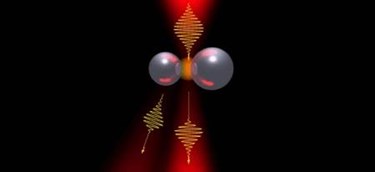A New Twist: Silicon Nanoantenna Launched Light

The team of physicists from the University ITMO, MIPT and the University of Texas at Austin has developed an unusual nanoantenna that can scatter light in the desired direction, depending on the intensity of the incident radiation. The results open the way to a flexible optical information processing in telecommunication systems.
Photons - the carriers of the electromagnetic radiation or quanta of light - have no mass and electric charge. For this reason, a relatively hard to control light, in contrast to, for example, electrons. Their movement in the electronic structures controlled by applying a constant electric field. However, such devices as nanoantenna, allow to achieve a certain degree of control in the propagation of electromagnetic waves.
One of the tasks that require "advanced" light control is to create optical computers. In these devices, the information carrier are not electrons but photons. The use of light instead of the charged particles will eventually increase the transmission speed and processing order information. For the realization of such computing devices require special nanoantenna, the characteristics of which can be controlled in any way, for example, constant electric or magnetic field or the intensity of the incident light.
In their paper published in the Laser & Photonics Reviews, researchers have developed a new non-linear device nanoantenna, which allows you to change the direction of light scattering, depending on the intensity of the incident wave (Fig. 1). The basis of the proposed nanoantenna are silicon nanoparticles, which under the action of intense laser radiation is generated electron plasma.The authors have demonstrated the possibility of such nanoparticles for nonlinear and ultrafast light control (as we wrote earlier).Then the researchers were able to control the scattered light forward and back shares. Now, scientists have been able to turn scattered light beam in the desired direction, depending on the intensity of incident light.
To rotate the directional pattern nanoantenna authors used the mechanism of plasma generation in silicon. Nanoantenna is a dimer - two silicon nanospheres of different diameters. When laser beam irradiation weak light scattering on such an antenna direction occurs due to asymmetrical geometry (blue diagram in Fig. 2a). The diameters of the nanoparticles are selected so that at the laser wavelength, one of them is resonant. Upon irradiation with a powerful laser pulse in her intensive generation of electron plasma, which leads to a change in the optical properties of the particles. The other particle - non-resonant and powerful laser field is almost no effect on its properties. Speaking roughly, the correct choice of two sizes of particles of the incident beam parameters (duration and intensity) are effectively "the same", and the antenna emits light forward (red curve in Fig. 2a), the particle size.
" Existing optical nanoantenna allow you to control the light in a fairly wide range. However, this "skill" is generally "hardwired" in their geometry and the materials of which made the antenna, and a simple change of these characteristics is impossible, - says the opening of post-graduate MIPT, one of the authors of Denis Baranov. - Nanoantenna that we developed, allows you to dynamically manage their properties. When you shine on her weak pulse - you get a result, and with a strong laser pulse get completely different behavior! "
For a more complete picture of the scientists conducted a numerical simulation of the described mechanism (Fig. 2b). The irradiation of the weak laser beam is scattered to the side, and the direction of the radiation hardly changes during the pulse action (blue curve). If nanoantenna irradiate intense laser which leads to the generation of electron plasma occurs chart rotation by 20 degrees (red curve). Thus, it is possible to deflect in different areas of weak and strong pulses falling.
Senior Research Fellow Department of nanophotonics and metamaterials University ITMO Sergey Makarov concludes: " In this study we focused on the development of nanoscale optical chip size of less than 200h200h500 nm, ie a fraction of wavelength of the photon, the carrier of information. The new element will allow to change the direction of the propagation of light pulses at a rate hundreds of times greater than electronic counterparts. Our device can allow to distribute the signal to two optical channels with extremely short intervals, which is very important for modern telecommunications systems. "
Today, information is transmitted over fiber with record speed to hundreds of Gb / s. However, currently existing electronics processes the speed signal from only a few Gbit / s for a single element. Creating a nonlinear optical nanoantenna will solve this problem. Performance of the antenna proposed by the authors is 250 Gbit / s. This will open the way for ultra-fast optical information processing. Nonlinear antenna, developed by researchers, provides even more opportunities for lighting control at the nanoscale, which is necessary for the implementation of photonic computers and various devices.
Source: Moscow Institute of Physics and Technology
